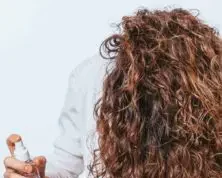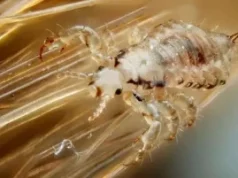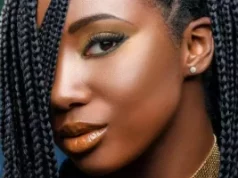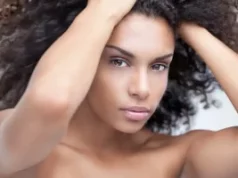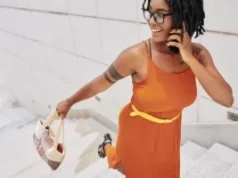You may want to know what color can I dye my hair after blue. Then you are at the right page.
You’ve come to the right site whether you used the wrong shade of blue hair dye or you’re not too happy with the results, but what colour covers up blue hair?
By the time you finish reading this essay, you’ll understand how to cancel out and remove blue hair dye without damaging your mane.

What are the Colors that Cancels Out Blue Hair?
Colors that cancel out blue hair are those that are opposite on the color wheel, which includes orange and its various shades. Orange is considered the complementary color to blue, and using orange-toned products can help neutralize and counteract the blue tones in your hair. Here are some options:
- Orange: A warm orange hair color or an orange-toned toner can effectively cancel out blue tones. This can be especially useful if your hair has a strong blue cast.
- Copper: Copper is a reddish-brown shade that contains strong orange undertones. It can be used to counteract blue hues and bring warmth back to your hair.
- Red: Red hair colors, especially those with orange or warm undertones, can help neutralize blue tones and create a more balanced result.
- Warm Brown: If you’re not looking for a drastic change, a warm brown hair color with hints of red or orange can help neutralize blue without going too far from your natural color.
- Peach: Peachy tones can also work to counteract blue hues. They provide a softer alternative to more intense orange shades.
When using these colors to neutralize blue hair, it’s important to keep in mind the current shade of your hair and the desired outcome. If you’re unsure about the process, it’s advisable to consult with a professional colorist who can recommend the best approach based on your hair’s condition and the desired final result. Additionally, color-correcting shampoos and conditioners designed to combat unwanted tones can also be used to help neutralize blue hair gradually.
Also Read: What Color cancels out green? How to neutralize green color
What Color Can I Dye My Hair After Blue?
After having blue hair, you have a range of options for the next hair color you can dye it. Since blue is a cool tone, you might consider transitioning to warmer colors to create a balanced and harmonious look. Here are some color options to consider:
- Golden Blonde: Transitioning to a golden blonde shade can provide a warm and sunny look that complements your skin tone and helps balance out any remaining blue tones in your hair.
- Caramel Brown: Caramel brown shades offer warmth and depth. They can create a beautiful contrast with any lingering cool tones from the blue hair.
- Auburn: Auburn hues with reddish undertones can add vibrancy to your hair and counteract the coolness of the blue. This color can range from subtle to bold, depending on your preference.
- Copper: If you’re looking for a more daring option, copper can be a great choice. It’s a reddish-brown shade with strong warm undertones that can effectively neutralize any remaining blue tones.
- Warm Brown: A warm brown shade, closer to your natural hair color but with added warmth, can provide a natural yet refreshed appearance.
- Strawberry Blonde: This shade blends blonde and red tones, creating a soft and flattering look that can help offset any cool undertones from the blue dye.
Remember that the final outcome can depend on factors such as your hair’s starting shade, texture, and porosity. It’s also important to properly prepare your hair before dyeing it again, especially if you’re moving from a vibrant color like blue to a new shade. If you’re unsure about the best approach or how a specific color might look on your hair, consider consulting with a professional colorist. They can guide you through the process and help you achieve the desired result while maintaining the health of your hair.
Valuable Tips For Dyeing Your Hair To A Vivid Color
Dyeing your hair a vivid color can be a fun and exciting way to express your creativity. However, achieving and maintaining vibrant shades requires careful preparation and aftercare. Here are some valuable tips to consider when dyeing your hair a vivid color:
- Pre-lighten: For vivid colors to show up vibrantly, your hair might need to be pre-lightened, especially if your natural color is dark. This step is crucial to create a blank canvas for the vivid color to pop.
- Quality Products: Invest in high-quality hair dye and bleach. Cheaper products might not give you the desired results or could damage your hair.
- Prepare Your Hair: Ensure your hair is healthy before dyeing. Deep condition your hair leading up to the dyeing process to minimize damage.
- Clean Hair: Wash your hair a day or two before dyeing. Natural oils can help protect your scalp during the coloring process.
- Protect Your Skin and Clothing: Apply petroleum jelly along your hairline and wear old clothing or a dyeing cape to prevent staining.
- Section Your Hair: Divide your hair into manageable sections before applying the dye. This ensures even application.
- Use Gloves: Wear gloves to protect your hands from staining.
- Follow Instructions: Read and follow the instructions on the dye packaging carefully. Each dye might have specific guidelines for mixing and applying.
- Processing Time: Stick to the recommended processing time. Leaving the dye on for too long can damage your hair or lead to uneven results.
- Rinse with Cold Water: After processing, rinse your hair with cold water. Cold water helps seal the hair cuticle and preserve the color.
- Color-Safe Products: Use color-safe shampoos and conditioners to extend the life of the color. Harsh shampoos can cause the color to fade quickly.
- Avoid Frequent Washing: Try to limit washing your hair to every few days to prevent the color from fading quickly.
- Dry Shampoo: On non-wash days, use dry shampoo to absorb excess oil without stripping the color.
- UV Protection: Sun exposure can cause color fading. Consider using UV protection products for your hair when going outside.
- Touch-Ups: As your color fades, you might need to do touch-ups. Follow the same process as the initial dyeing.
- Professional Help: Achieving and maintaining vivid colors can be challenging. If you’re unsure, consider consulting a professional colorist for the best results.
- Expect Maintenance: Vivid colors tend to require more maintenance than traditional shades. Be prepared for touch-ups and upkeep.
Remember that vivid colors can be high-maintenance but also incredibly rewarding. Taking proper care of your hair and using the right products can help you enjoy your vibrant look for as long as possible.
Also Read: How long to leave toner in Hair? All you need to know
Steps How To Neutralize Blue Hair
Neutralizing blue hair involves using colors that are opposite on the color wheel to cancel out the blue tones. Here’s a step-by-step guide on how to neutralize blue hair:
- Assess Your Hair: Take a look at your current hair color and the intensity of the blue tones. This will help you determine the best approach and the colors you need to use.
- Choose the Neutralizing Color: Select a color that is opposite to blue on the color wheel. Typically, warm tones like orange, copper, red, and warm brown are effective for canceling out blue.
- Prep Your Supplies: Purchase the hair dye or toner in the chosen neutralizing color. Make sure you have all the necessary supplies, including gloves, mixing bowl, applicator brush, and an old shirt or towel to protect your clothing.
- Test a Strand: Before applying the neutralizing color to your entire head, it’s a good idea to test it on a small strand of hair. This will help you gauge the results and adjust the processing time if needed.
- Apply the Color: Follow the instructions provided with the hair dye or toner. Apply the color evenly to your hair, focusing on areas with the most prominent blue tones. Start from the roots and work your way to the ends.
- Follow Processing Time: Let the color develop according to the recommended processing time. This time can vary based on the product you’re using and your hair’s condition.
- Rinse and Condition: Once the processing time is up, rinse your hair thoroughly with cool water until the water runs clear. Apply a conditioner to help maintain moisture and smoothness.
- Assess the Results: After your hair is dry, assess the results. The neutralizing color should have counteracted the blue tones, resulting in a more balanced hair color.
- Consider Color-Correcting Products: If you prefer a gradual approach, you can use color-correcting shampoos and conditioners designed to fade unwanted tones over time.
- Consult a Professional: If you’re unsure about the process or if you’re dealing with a complex color correction, consider consulting a professional colorist. They can provide expert guidance and ensure the best results.
Remember that achieving the desired outcome might take some trial and error, especially if your blue hair is deeply pigmented. Patience is key, and if you’re uncertain, it’s always a good idea to seek professional assistance to ensure a successful neutralization of the blue tones.
What To Consider When Picking A New Dye?
When picking a new hair dye, there are several factors to consider to ensure you choose the right color and product for your hair. Here’s a list of things to keep in mind:
- Current Hair Condition: Consider the current state of your hair. If your hair is damaged or has been previously colored, certain dyes might not adhere well or could cause further damage. Choose a dye that is appropriate for your hair’s health.
- Skin Tone: Your skin tone plays a significant role in how different hair colors will look on you. Certain colors may complement your complexion better than others. Warm tones like reds and coppers are often suited for warm skin tones, while cool tones like ash blonde or cool brown can suit cooler skin tones.
- Eye Color: Your eye color can also impact how different hair colors appear on you. Some colors can enhance the natural beauty of your eyes.
- Personal Style and Preferences: Consider your personal style and the image you want to project. Are you looking for something subtle or bold? Classic or trendy? Your personal preferences should guide your choice.
- Maintenance Level: Different hair colors require varying levels of maintenance. Vibrant or light shades may require more frequent touch-ups, while darker shades may have longer-lasting results. Choose a color that aligns with the amount of maintenance you’re willing to commit to.
- Natural Hair Color: Your natural hair color can influence how the new dye will turn out. The starting point matters, especially if you’re transitioning from a bold color like blue to a new one.
- Professional vs. At-Home Dyeing: Decide whether you’re comfortable dyeing your hair at home or if you prefer to have it done professionally. Some colors or techniques might be more challenging to achieve on your own.
- Color Swatches and Samples: Many hair dye brands offer color swatches or sample images of how the color will look on different hair types. Check these out to get an idea of what to expect.
- Quality of the Dye: Research the brand and product reviews to ensure you’re choosing a quality dye that will deliver the desired results without damaging your hair.
- Color Fade: Keep in mind that all hair colors fade over time due to washing and exposure to the elements. Consider how the color will evolve and if you’re okay with the potential fading.
- Hair Type and Porosity: Different hair types and levels of porosity can impact how color is absorbed and retained. Thicker, coarser hair might require a different dyeing approach than fine hair.
- Consult a Professional: If you’re uncertain about the best color for your hair type, skin tone, and overall goals, consider consulting a professional colorist. They can provide personalized advice and help you achieve the desired result.
Remember that hair dye is a creative way to express yourself, but it’s important to make an informed choice to ensure you’re happy with the outcome.
Also Read: Long layers vs Short Layers common difference you should Know
Frequently Asked Questions
Here are some frequently asked questions related to hair dyeing and hair color:
How long does semi-permanent hair dye last?
Semi-permanent hair dye typically lasts for about 4 to 6 weeks, depending on factors like hair porosity, maintenance, and how often you wash your hair.
Can I dye over my current hair color?
Yes, you can dye over your current hair color, but the results may vary based on the new color you choose and your hair’s current shade. Pre-lightening might be necessary for drastic color changes.
How can I make my hair color last longer?
To make your hair color last longer, use color-safe shampoos and conditioners, wash with cold water, limit exposure to the sun and chlorine, and avoid excessive heat styling.
Will dyeing my hair damage it?
Dyeing your hair can cause some damage, especially if you’re using bleach or lightening products. Proper care and deep conditioning can help minimize damage.
Can I dye my hair at home or should I visit a salon?
You can dye your hair at home, but for complex color changes or if you’re unsure, it’s advisable to consult a professional colorist. They can ensure the best results and minimize potential damage.
How can I remove hair dye if I don’t like the color?
If you’re unhappy with the color, there are color-removing products available. Consulting a professional colorist is also a good option for safe color correction.
Can I dye my hair while it’s already colored?
Yes, you can dye hair that’s already colored, but the outcome might be influenced by the existing color. Darker colors are easier to dye over than lighter ones.
How often can I dye my hair?
Dyeing your hair too frequently can lead to damage. It’s generally recommended to wait at least 4-6 weeks between dyeing sessions.
Will the color on the box match how it looks on my hair?
The color on the box might look different on your hair due to factors like your natural hair color and undertones. A strand test can give you a better idea of the final result.
What should I do if I have allergies to hair dye?
If you have allergies to hair dye, perform a patch test before using any new product. If you experience a reaction, consult a doctor.
Can I dye my hair if I’m pregnant?
While some experts consider hair dye safe during pregnancy, it’s recommended to consult your healthcare provider to make an informed decision.
How do I fix uneven color after dyeing?
Uneven color can be fixed by applying the dye more evenly, possibly with the help of a friend. If the issue is significant, consulting a professional might be necessary.
Remember, every individual’s hair is unique, so results can vary. If you’re unsure or have specific concerns, it’s always a good idea to seek advice from a professional colorist.


